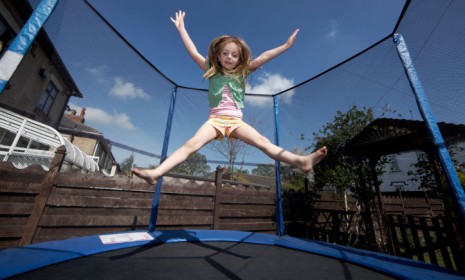The dangers of owning a home trampoline: By the numbers
The American Academy of Pediatrics is now recommending that parents remove the bouncy — and hazardous — contraptions from their backyards

Trampolines can provide hours of fun, but they can also lead to serious life-altering injuries. In 1999, the American Academy of Pediatrics (AAP) required manufacturers to add safety features like surrounding safety nets to mitigate risk. But now, after assessing years of findings, the AAP says the features provide a false sense of security, and the group is urging pediatricians to discourage parents from setting up trampolines at their homes. Though the estimated number of trampoline injuries nationwide has been decreasing, the recreational devices are still considered dangerous. Here, a look at the numbers behind this risky contraption:
111,851
Trampoline-related injuries treated in the ER in 2004
The Week
Escape your echo chamber. Get the facts behind the news, plus analysis from multiple perspectives.

Sign up for The Week's Free Newsletters
From our morning news briefing to a weekly Good News Newsletter, get the best of The Week delivered directly to your inbox.
From our morning news briefing to a weekly Good News Newsletter, get the best of The Week delivered directly to your inbox.
97,908
Trampoline-related injuries treated in 2009
3,100
Those who were required to remain in the hospital in 2009
A free daily email with the biggest news stories of the day – and the best features from TheWeek.com
10,700
Children in the U.S. hospitalized every year as a result of bicycle crashes
61,000
Children in the U.S. injured every year because of skateboarding
85
Percentage of the approximately 900,000 consumer trampolines sold each year that include a safety net
75
Percentage of trampoline-related injuries resulting from multiple people jumping on the mat at the same time
48
Percentage of injuries in the 5-and-under age range that result in fractures or dislocations
27 to 39
Percentage of all injuries caused by falls. These can be "potentially catastrophic," says the AAP
20
Percentage of injuries caused by direct contact with the springs or frame
50
Percentage of injuries that damaged the lower extremities, including ankle sprains
10 to 17
Percentage of injuries to the head and neck, which are less common but can cause "permanent neurological damage"
Sources: American Academy of Pediatrics, Babble, My Health News Daily, Racing for Safety [PDF]
-
 Film reviews: ‘Marty Supreme’ and ‘Is This Thing On?’
Film reviews: ‘Marty Supreme’ and ‘Is This Thing On?’Feature A born grifter chases his table tennis dreams and a dad turns to stand-up to fight off heartbreak
-
 Political cartoons for December 14
Political cartoons for December 14Cartoons Sunday's political cartoons include a new White House flag, Venezuela negotiations, and more
-
 Heavenly spectacle in the wilds of Canada
Heavenly spectacle in the wilds of CanadaThe Week Recommends ‘Mind-bending’ outpost for spotting animals – and the northern lights